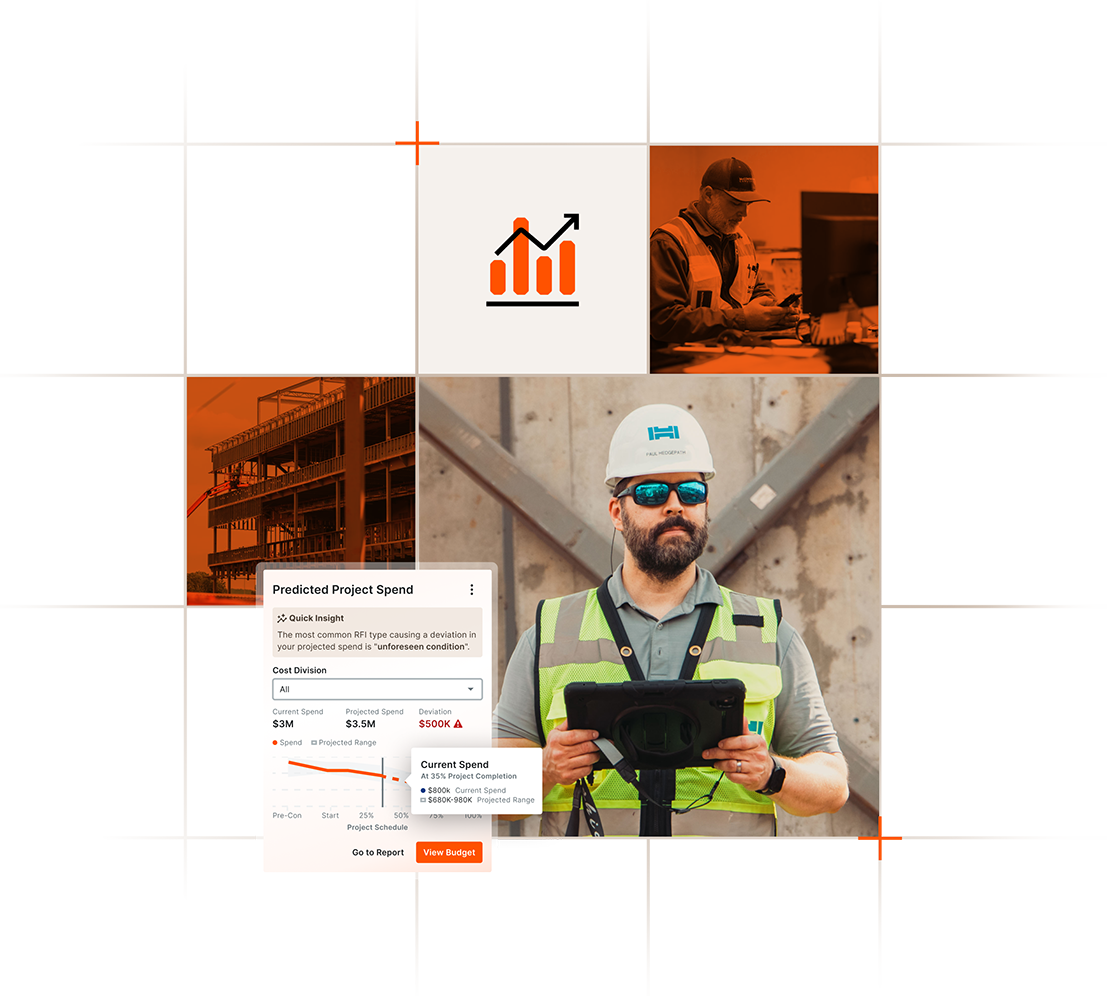— 8 min read
5 Mindsets Behind Effective Digital Strategies in Construction


Last Updated Dec 16, 2025

Tannis Liviniuk
CEO
Tannis Liviniuk is CEO of Livinuik Group. She has 23 years of industry experience, with her career beginning in the field, accumulating a wealth of hands-on expertise in the intricacies of project planning, project controls, construction execution, and digital solution implementation. Since then, she has served in management and corporate leadership roles with global facility owner, technology, consulting, and EPC organizations to develop and optimize processes, deploy new technologies, and to guide and support digital transformations and initiatives. Tannis is an active industry advancement advocate. She has been a guest lecturer at the University of Houston and for the Construction Industry Institute (CII) at the University of Texas at Austin. She speaks at conferences globally on topics such as industry innovation, emerging technologies, digital transformation, and advancing opportunities for women in construction. She has a master’s degree in business administration and is certified in project management by Stanford University's Center for Professional Development. In 2020, Tannis was named in the Top 40 Under 40 in Canadian Construction by SiteNews, and in 2022 received the Rising Star Alumni Award from Athabasca University.

James Hamilton
Writer & Producer
85 articles
James Hamilton is a writer based in Brooklyn, New York with experience in television, documentaries, journalism, comedy, and podcasts. His work has been featured on VICE TV and on The Moth. James was a writer and narrator for the show, VICE News Tonight, where he won an Emmy Award and was nominated for a Peabody Award.
Last Updated Dec 16, 2025

Finding success in the increasingly fast-paced world of digital construction comes down to a contractor's ability to make decisions that align with their long-term goals.
A digital strategy is a plan that outlines how a construction company will adopt, implement and use technologies to achieve business and project objectives. An effective strategy can help avoid falling behind, being overwhelmed by change or wasting resources. Even more, a strategy helps to assess the value of new tools, make informed decisions about investments and realize a tool’s potential to enhance efficiency, improve collaboration and gain an edge in a competitive market.
The foundation of an effective digital strategy is built on mindsets that help firms stay aligned with their long-term objectives and effectively adopt technology, while always prioritizing communication and safety.
Table of contents
Mindset 1: Find the intersection between process and current tech capabilities.
The goal of any innovation is to optimize the construction process, but achieving that requires an understanding of both the innovation and the process. It’s a tricky balance. Some contractors focus too much on innovation — adopting technologies because they’re new or exciting. Others become rigid in how they think about their processes — becoming set in the idea that, “This is how we do things.”
A digital strategy should give balanced consideration to the ways a contractor operates and to the capabilities of tech that’s currently on the market. Finding this balance can usually be done by working backwards, which might look like this:
- Identify end goals, which might include a business objective, a target for project efficiency or a vision for client experience.
- Map out processes by identifying key workflows, sequencing the steps of that workflow and analyzing efficiency.
- Explore the tech that’s available and projections for future innovations with the understanding of the end goal and the processes.
This type of deliberate and balanced consideration can help find tools that complement existing processes, minimize wasted resources and maximize business value.
There is sometimes a stigma around the innovation group or the R&D group. That they end up with a bunch of money, go into a box, do magic and then, at some point, something pops out. That’s often because those groups are not well-structured, but I think the process of play is a critical element in understanding technology. Specifically, understanding technology that exists in the industry now, what that technology is capable of doing and how that technology might be applied internally.
At some point, when your processes are mapped out and your foundational data elements are established and in place with trusted sources of data, you can determine what tech in an ideal world would look like for you and what is possible today. Those streams, at some point, need to intersect.

Tannis Liviniuk
CEO
Liviniuk Group
Mindset 2: Reframe the product.
Defining the product impacts priorities and how success gets measured. Contractors that set themselves apart from the competition are often the ones that recognize that their product isn’t just completed structures; it’s also customer service and efficient logistics.
Contractors who view themselves primarily as builders of structures can become narrowly focused on the execution of tasks. Their key performance indicators (KPIs) are usually aimed towards measuring whether those tasks were finished and when. In turn, their digital strategy will focus on finding tools to enhance the completion of individual tasks, often without regard for how it fits with the rest of the project.
Contractors who view themselves primarily as builders of structures can become narrowly focused on the execution of tasks. Their key performance indicators (KPIs) are usually aimed towards measuring whether those tasks were finished and when. In turn, their digital strategy will focus on finding tools to enhance the completion of individual tasks, often without regard for how it fits with the rest of the project.
Meanwhile, successful projects require the ability to bring the right resources to the right people in the right place. Logistics are always an outsized part of the job.
Contractors that conceive of themselves as a logistics operation, similar to an airline or shipment company, gain a huge advantage. Success includes the efficiency of resource management and movement, including materials, equipment and labor. This shifts their digital strategy to prioritize tools that provide insights into the full life cycle of a project, such as using QR codes to track materials or investing in advanced data analytics.
Similarly, contractors that consider customer service as part of their product end up measuring success through the experiences of their clients. They are more likely to seek tools that increase communication, transparency and seamless handoffs, such as project management software or client portals that provide a centralized place to communicate, make decisions and track progress.
All contractors build. The speed and reliability of their work will always be part of the value they offer. A subtle shift in mindset that also emphasizes logistics and customer service can result in decision-making that is more holistic, strategic, focused on risk management and more likely to leave a lasting, positive impression on owners and clients.
If I put myself in the shoes of a customer, I have expectations around what the purchase entitles me to. If I buy something on Amazon, I can look at options, select the best option for me and I receive communication around the status of that purchase up until the point I have it in my hands. And then they’re asking me for feedback on how that experience was.
Construction doesn’t work like that at all. When you look at how construction gets executed in terms of project delivery, it’s a very fragmented process. There are a multitude of stakeholders on each project that all have their own version of that activity for their ultimate customer, but very rarely do they combine to hand over to the owner in a way that feels like a consumer-like experience.
Tannis Liviniuk
CEO
Liviniuk Group
Mindset 3: Be open to sharing and collaborating.
For much of the history of construction, protecting resources and information was an important part of contractors getting an edge in the industry. The growing importance of data is changing that to such an extent that, in some cases, being too protective of information can set companies back.
For firms, information might include data on efficiency or safety, lessons learned in specific sectors or environments and best practices for tech or innovation.
Sharing information and data between firms can build a more comprehensive view of industry trends and larger data sets that can be used to improve performance analysis and drive innovation across the industry.
Companies that are open to collaboration, especially smaller firms, often find themselves with access to data they wouldn’t otherwise have and can be used to improve decision making, mitigate risk and better assess the value of new technology.
Stay updated on what’s happening in construction.
Subscribe to Blueprint, Procore’s free construction newsletter, to get content from industry experts delivered straight to your inbox.

Mindset 4: Don’t mandate. Facilitate.
A lot goes into effectively adopting new technology, from initially evaluating the tool, getting leadership buy-in to implementation. It’s a process that can take a while to get right and that depends on users — the people actually using the new tool — engaging with enthusiasm, curiosity and trust.
Mandating the use of technology can create resistance, especially if people don’t understand its purpose, benefits or the reasons for its adoption. This can lead to “malicious compliance,” a dynamic when workers follow requirements but do so, at best, half-heartedly and, at worst, with active resentment. This can greatly impact how effectively a tool is adopted and can even lead to safety or cybersecurity risks.
Facilitating the use of a new tool empowers users to implement it in ways that feel transformative to them. This often requires quality training and support, but it can also be as simple as taking time to talk to workers about new tech, hear their concerns and provide rationale and examples of its potential. In some cases, it can be helpful to identify and rely on “champions of change,” which are people who are excited to pilot a new solution and advocate for adoption among colleagues.
There is a substantial willingness to use technology that actually works and supports workflows, provided the tools are there and training and education is available to support people actually learning how to use it.
Tannis Liviniuk
CEO
Liviniuk Group
A long-term digital strategy also creates entry points for people to discover, research and pitch new tools that they think might improve their work. This might include creating dedicated innovation roles or committees and investing in team members attending conferences.
Mindset 5: Think long term.
The goal of a digital strategy is to help make forward-thinking decisions and proactively navigate change, as opposed to reacting to the problems and genuinely cool tech that will inevitably pop up along the way. Part of long-term success is as simple as regularly revisiting a digital strategy. Strategies need updating, sometimes as often as every 12 to 18 months, to help keep up with technological advancements or simply refine over time.
Many of the mindsets in this article are meant to help shift the decision-making process towards focusing on the future. Working with more data, perhaps through tools that monitor logistical efficiency or sharing with other firms, presents infinite ways to improve and adapt over time.
Facilitating tech adoption in ways that are empowering and exciting helps to attract and retain tech-savvy talent. In the big picture, being engaged with trends, innovations and new challenges can help create a digital strategy that is proactive and sets up a company for sustained success, growth and consistent competitiveness for years to come.
NOV 6, 2025 at 11:00 AM PST / 2:00 PM EST
Free Webinar: Prove your project management software is profitable
Join Procore and Dodge Data & Analytics for a 2025 Dodge ROI Report deep dive.

Was this article helpful?
Thank you for your submission.
0%
0%
You voted that this article was . Was this a mistake? If so, change your vote
Scroll less, learn more about construction.
Subscribe to The Blueprint, Procore’s construction newsletter, to get content from industry experts delivered straight to your inbox.
By clicking this button, you agree to our Privacy Notice and Terms of Service.
Thank you!
You’re signed up to receive The Blueprint newsletter from Procore. You can unsubscribe at any time.
Categories:
Written by

Tannis Liviniuk
CEO | Liviniuk Group
Tannis Liviniuk is CEO of Livinuik Group. She has 23 years of industry experience, with her career beginning in the field, accumulating a wealth of hands-on expertise in the intricacies of project planning, project controls, construction execution, and digital solution implementation. Since then, she has served in management and corporate leadership roles with global facility owner, technology, consulting, and EPC organizations to develop and optimize processes, deploy new technologies, and to guide and support digital transformations and initiatives. Tannis is an active industry advancement advocate. She has been a guest lecturer at the University of Houston and for the Construction Industry Institute (CII) at the University of Texas at Austin. She speaks at conferences globally on topics such as industry innovation, emerging technologies, digital transformation, and advancing opportunities for women in construction. She has a master’s degree in business administration and is certified in project management by Stanford University's Center for Professional Development. In 2020, Tannis was named in the Top 40 Under 40 in Canadian Construction by SiteNews, and in 2022 received the Rising Star Alumni Award from Athabasca University.
View profile
James Hamilton
Writer & Producer
85 articles
James Hamilton is a writer based in Brooklyn, New York with experience in television, documentaries, journalism, comedy, and podcasts. His work has been featured on VICE TV and on The Moth. James was a writer and narrator for the show, VICE News Tonight, where he won an Emmy Award and was nominated for a Peabody Award.
View profileExplore more helpful resources

Transforming Construction Project Management With Predictive Analytics
Construction leaders who can correctly identify project challenges before they arise can more easily sidestep them. This saves time, money and significant delays. Predictive analytics attempts to forecast future outcomes...

Capital Project Management: A Quick Guide for Construction Pros
With aging infrastructure and new technology needs, capital projects will remain a high priority for communities around the world in the coming years. Effectively managing capital construction projects is necessary...

Avoiding The App Trap: Overcome Financial Silos to Connect Field & Office
For general contractors working on razor-thin margins, rework and project delays are more than simple inefficiencies — they are major threats to the bottom line. For years, GCs have attempted...

Profit from Predictability: Construction Software as a Business Strategy
For general contractors, managing complex, multi-million-dollar projects, every project phase — from planning and budgeting to on-site execution — is an opportunity to lose time and money. Construction software is...
Free Tools
Calculators
Use our calculators to estimate the cost of construction materials for your next project.
Templates
Find a template to help you with your construction project tasks.
Material Price Tracker
Get the latest U.S. retail prices and view historical trends for common building materials.
Glossary
Explore key terms and phrases used in the industry.
